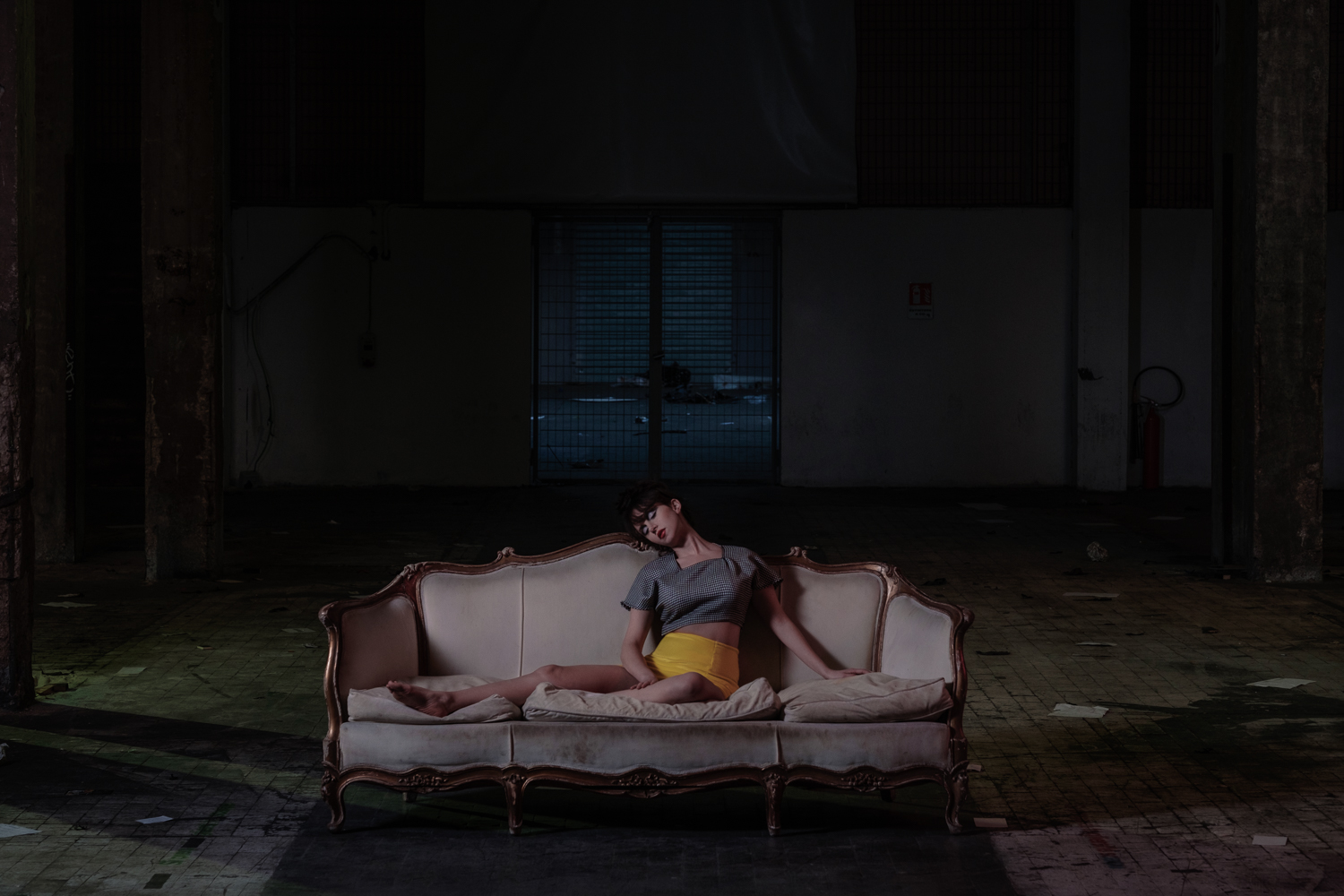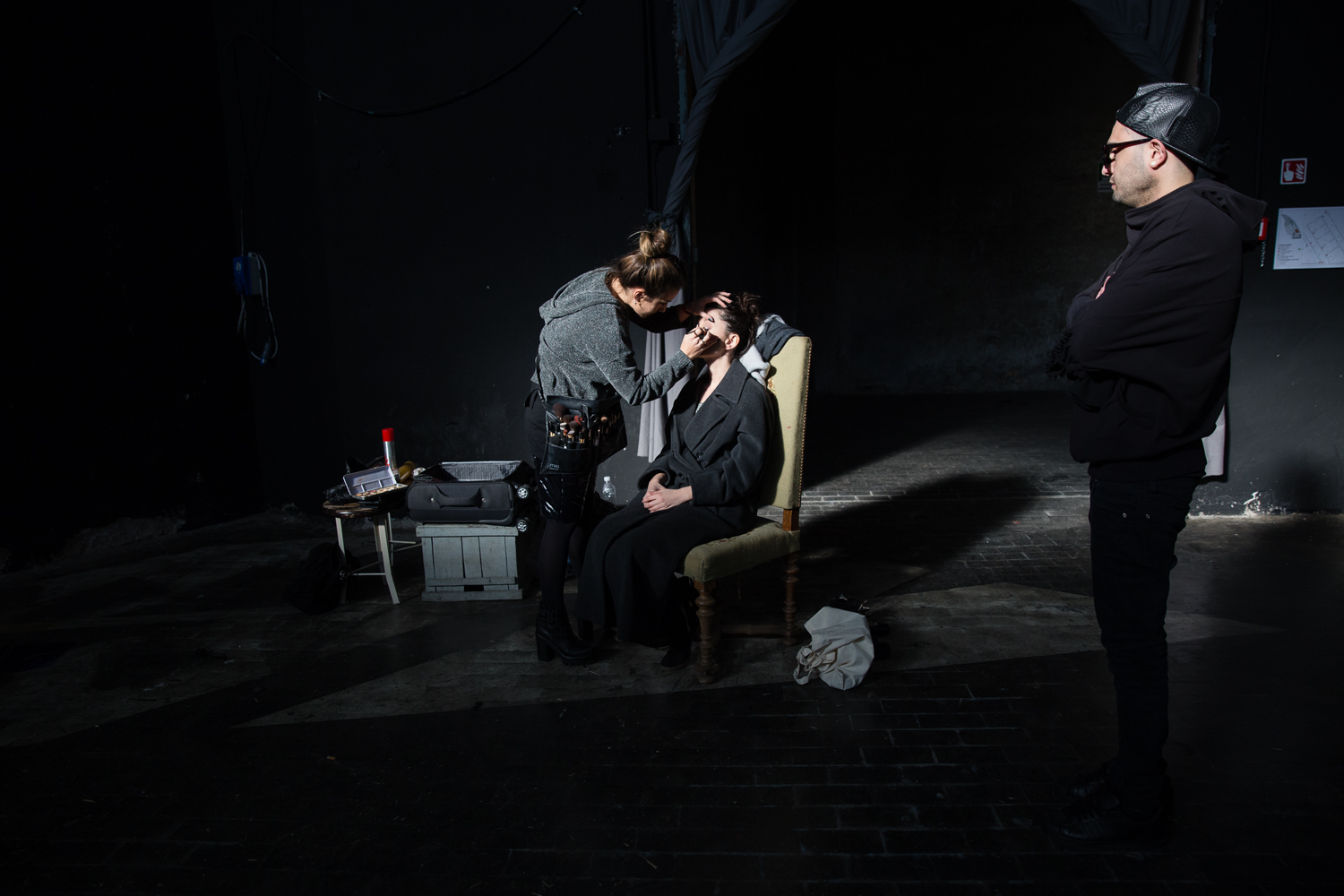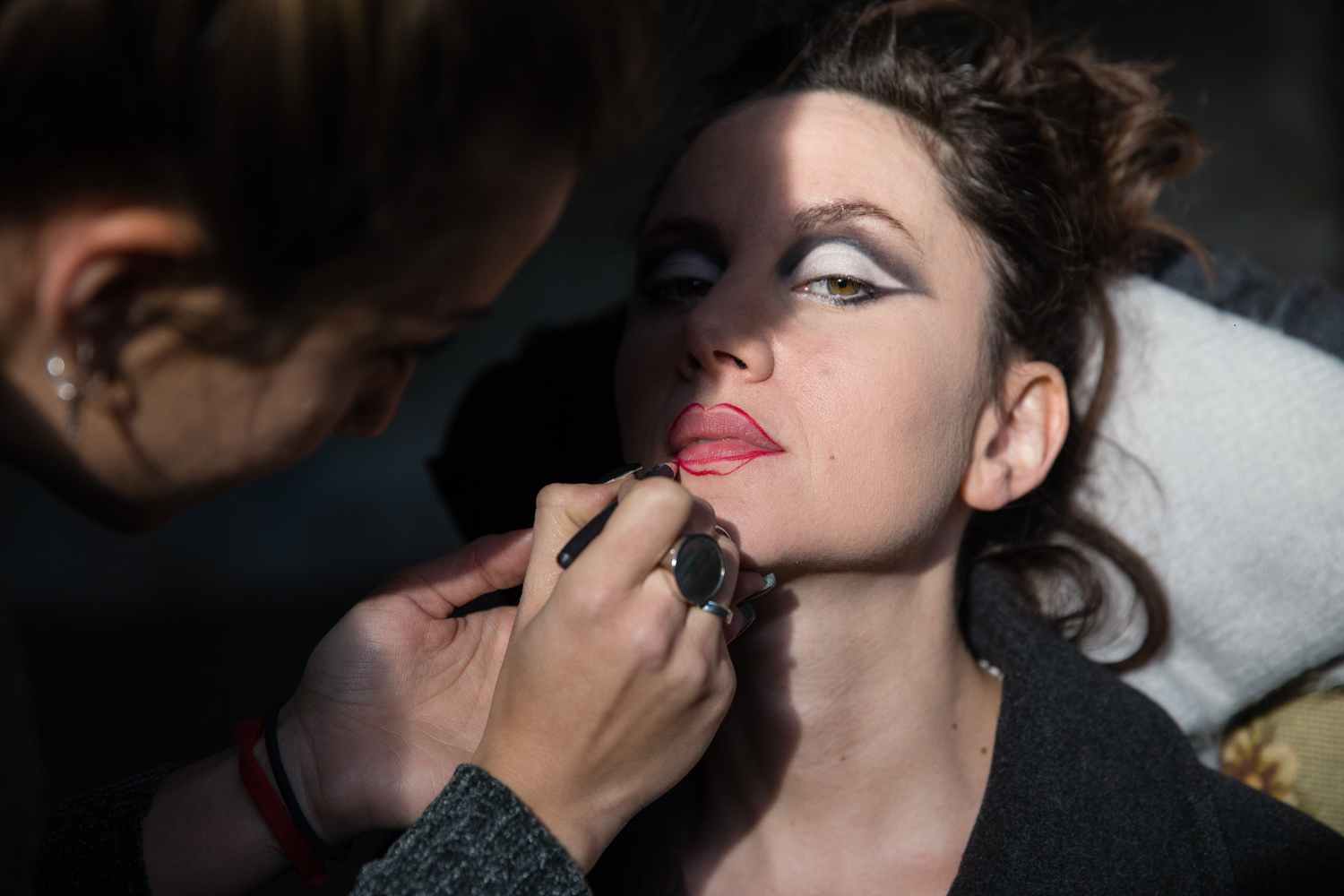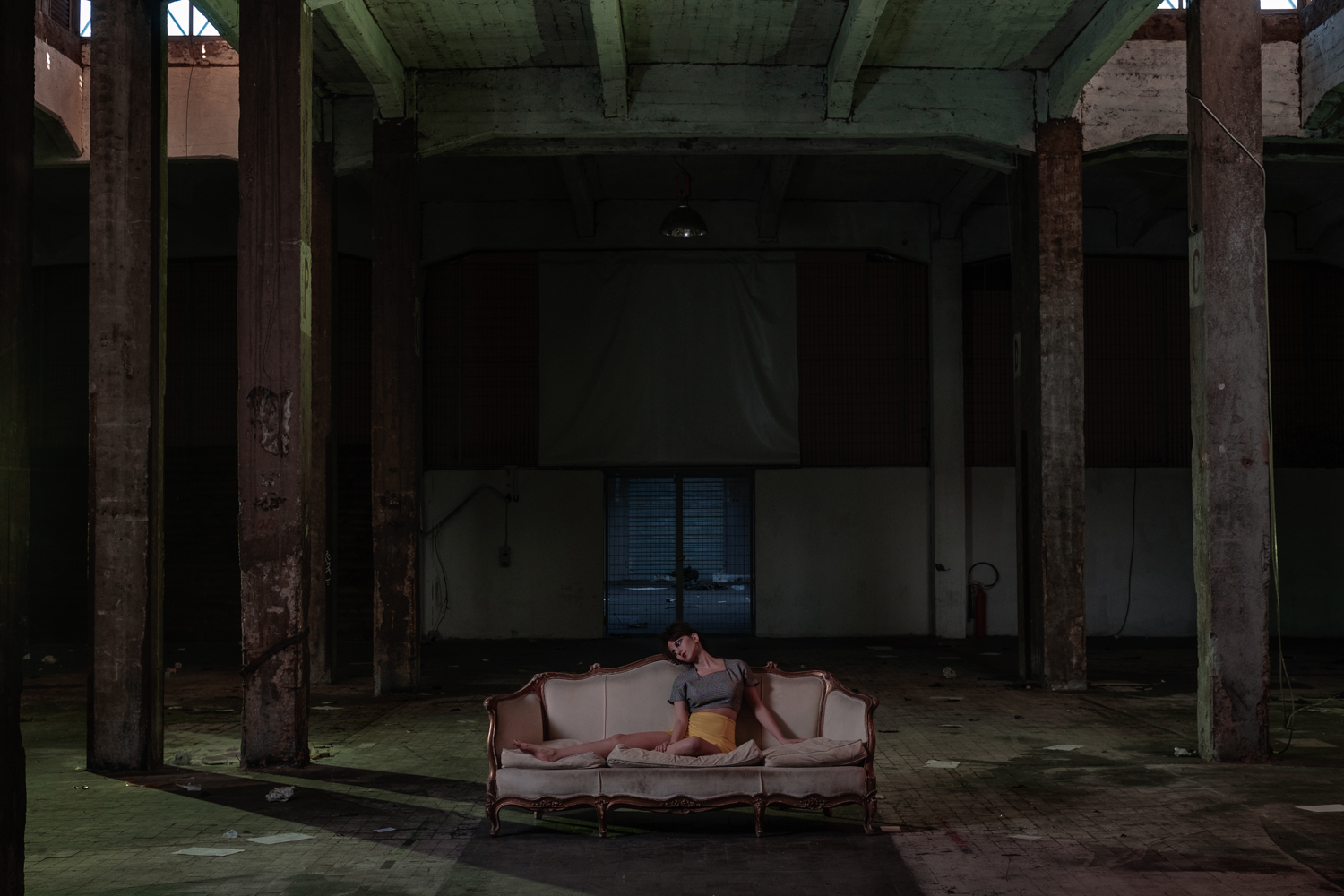This article is a follow up of last month’s “behind the scene” of one of my last projects, the one inspired by The Doors’ “the end”. Since in that article I’ve already covered all the background story, here I’ll summarize for those who haven’t read it and don’t intend to (why wouldn’t they, anyway?). After exhibiting six of my fashion/art pieces at the Ex-Dogana during “AltaRoma”, Rome’s Fashion Week, I had the opportunity to use the venue as a set for my photographs. Through Carlotta Giauna, one of the people responsible for what happens at the Ex-Dogana, I was put in contact with a young stylist, Vincent Wood, and a make-up artist, Angelica Muciaccia. I called a special actress/model for the occasion, Sofia Vigliar, because I needed someone intense and experienced for the job, which was to recreate dreamlike and unsettling scenes through the use of space, light, colors, and the model’s body interaction with all of this. At the end, we were quite a little crew for the project, with my counselor-and-wife Claudia, my two assistants Paola and Giacomo, then there were Carlotta, Vincent, Angelica, and Sofia.
While in my previous article I covered the background story and presented the first scene we created that day, today I want to show you the second scene with its preparation, setting, lights placing, model posing, and final results. Compared with the first scene, this time I used both the X100T equipped with the 50mm equivalent teleconverter and the X-T10 with the 85mm equivalent, in order to get the same scene with two different enlargements. I’ll talk about that in details, later, now let’s start with the preparation of the scene.
The first step for my work is always the location scouting. A few days after the end of “AltaRoma” I went back to the Ex-Dogana to see how the spaces looked like without all the settings mounted for the Fashion Week. I brought along both the X100T and the X-T10 with the 85mm equivalent so to be able to “collect” all the possible sets, while also testing the potential perspectives at different focal lengths. Among the various options, the room they call “the hangar” was definitely my favorite.
However, the huge room was still just partially dismantled. Carlotta promised me it would have been cleared for the shooting day. She was a girl of her word, because a couple of days after, when I went to the room to place the tripod, the place was in a much better shape, though the floor was still a mess. I decided the mess could stay, that it was actually adding drama to the scene. Especially all the white sheets of paper on the ground, they added texture and mystery.
The second step is to decide the styling/mood. I had a chance to see the mix of couches and sofas they had at the Ex-Dogana, and I spotted one that I wanted in the scene. With Vincent and Angelica, we discussed the best combination of clothes and make-up such a set. We decided for “modern sixties”, that is, clothes and make-up that looked like sixties but with an underground twist to it. It was a perfect match with both the set and the story I had in mind.
While Angelica and Vincent took care of the practical part of styling and make-up, I was with Paola and Giacomo setting up the set. I placed on tripods both the X100T, equipped with the 50mm equivalent teleconverter, and the X-T10, equipped with the 85mm equivalent, so that during the shooting I could choose when to capture a wide scene and when to focus on the subject. The cameras were placed in line, one immediately after the other, so to have the closest possible perspective. One thing I’ll have to get for future sets, is a second flash trigger, so that I don’t have to move the trigger between cameras.

photo by Paola Soldi. I work on the two cameras so to get the closest possible perspective and the same settings.
My set-up was an expanded version of the ultra portable studio I talked about a few articles ago. Here’s the list:
X100T with Fuji teleconverter;
X-T10 with Fujinon 56mm f1.2;
4 Yongnuo speedlite YN568EX II;
4 Yongnuo YN622C receivers;
one Yonguno YN622C-TX transmitter;
2 Velbon UT-43D II tripod;
2 standard flash stands, one micro stand and one boom;
a 120x80cm Color Quantum softbox;
a 60x60cm Delamay Easy Folder softbox;
a few clamps and a pack of super cheap gelatins.
Such an equipment can’t list as the “ultra portable”, yet I was amazed how I could fit all (but the boom) into one single studio trolley. Still very portable!
Paola and Giacomo placed the couch in the right spot, while I was behind the camera(s) to check the composition, then they took care to remove from the ground every piece of garbage that wasn’t white paper. In the meantime, I started setting up the lights.
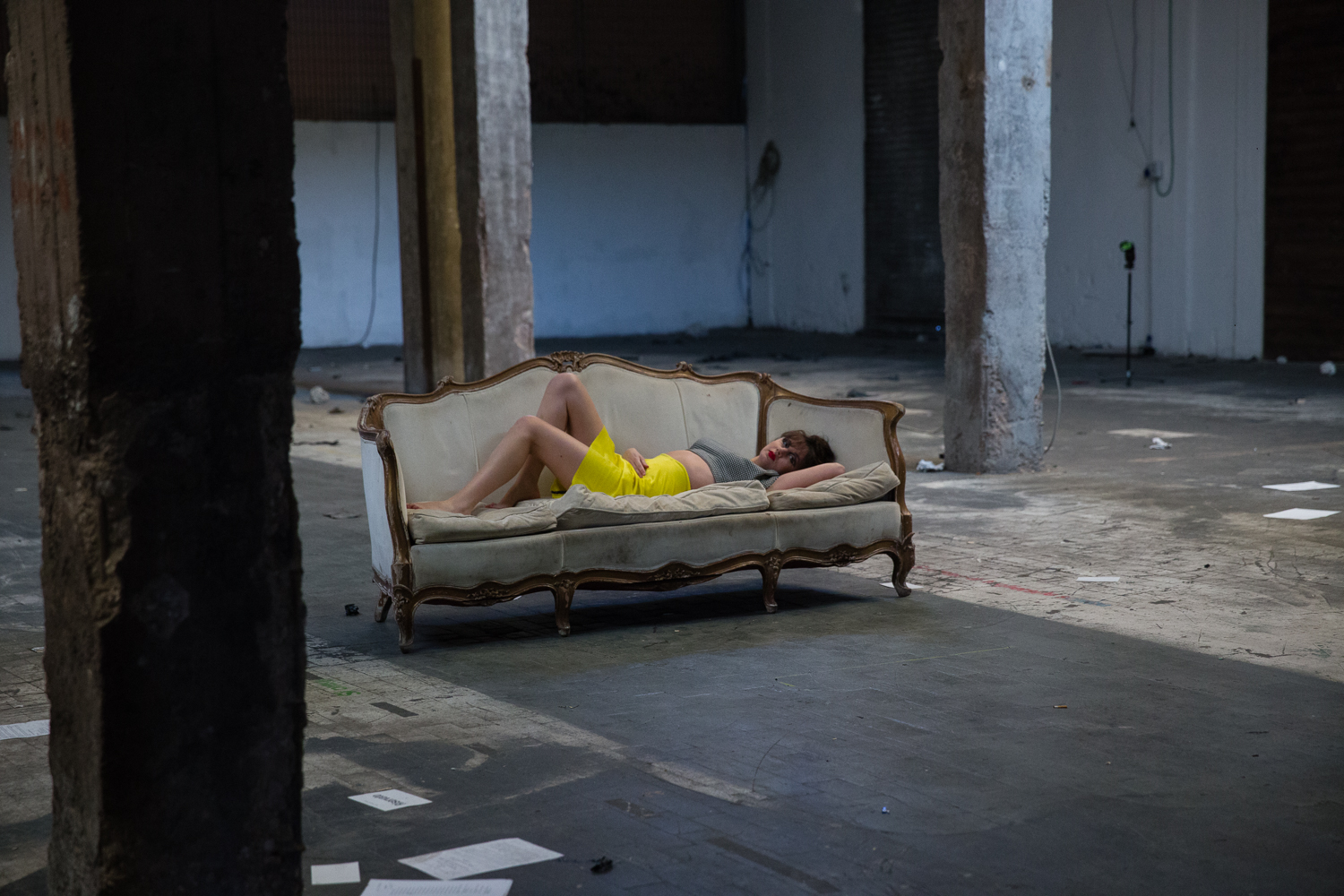
photo by Paola Soldi. From here you can see the position of the flash with the green gelatin on the micro stand.
Let’s start by saying that this was one of the hardest scene I had to light so far. Because it was HUGE. Very high ceiling, very wide room, which meant almost no light bouncing anywhere. It honestly took me a little longer than expected to figure out the proper positioning of the four flashes before I could be happy. But let’s go in order: for this scene, I wanted to mix the natural light, falling from the roof’s sides and slightly illuminating the other hangar behind the gate in the background, with the artificial and colored light of my flashes. So, the first thing I had to do was to manually set the cameras so they would get the proper exposure with the natural light. I opted for a ISO400, f/5, 1/40th combination. I knew (hoped) that the model, sitting, could have been still enough to be sharply captured even at that long shutter time, becauseI didn’t want to raise the ISO any further, nor to open the aperture and loose depth of field.
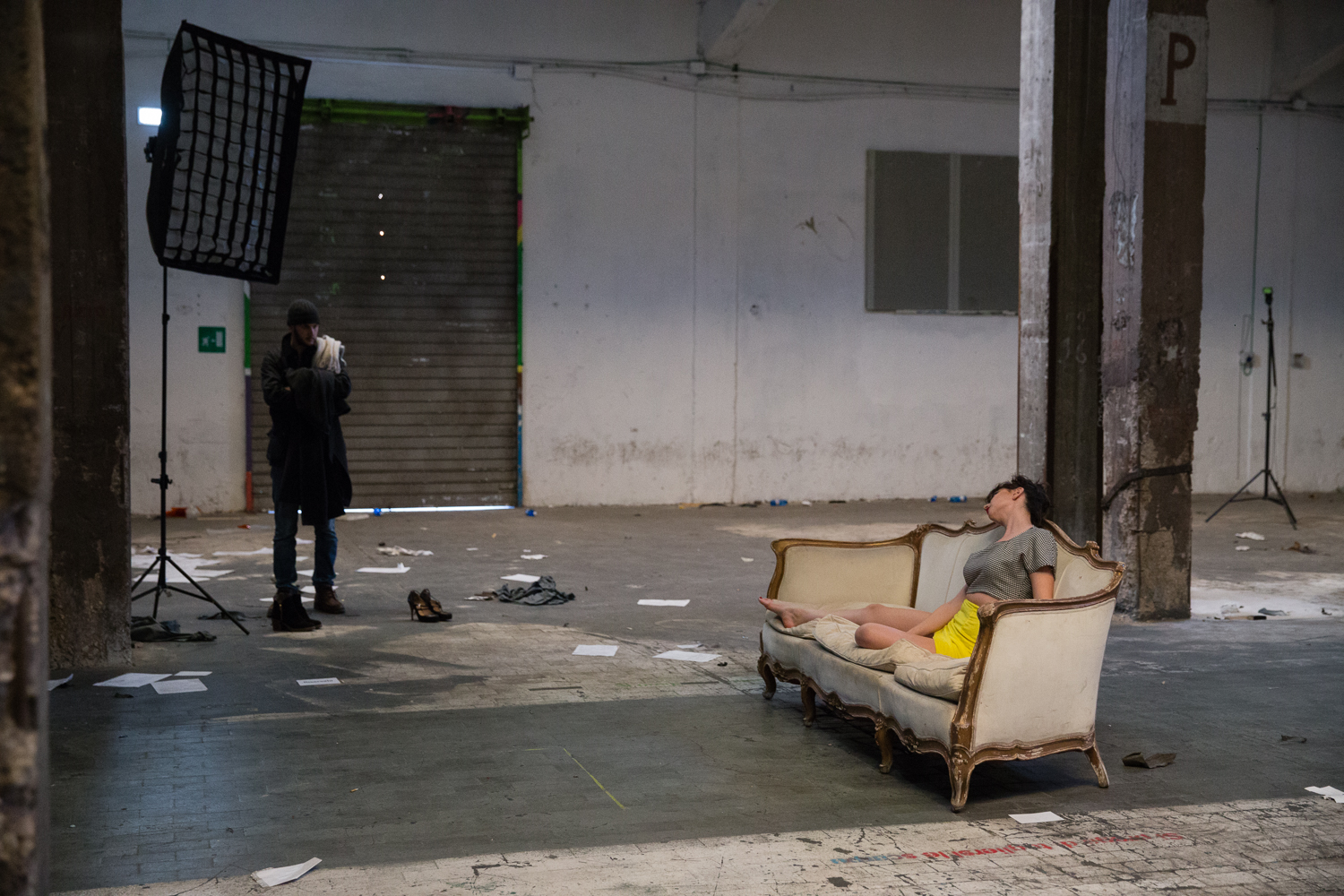
photo by Paola Soldi. From here you can see the position of the flash with the green gelatin on the boom, and of the big softbox. Giacomo is there to bring Sofia the coat whenever we’re pausing.
Once the exposure was fine with the natural light, I started placing and dosing the flashes. At first I placed two flashes on the background, with green gelatins on both. The one on the left was mounted on a boom, so it could point from above to the two columns, this way casting some hard shadows on the ground. The other one was mounted on the micro stand, aiming at the scene behind the couch, so to illuminate the last column on the right, adding some texture to what would have been otherwise a pretty empty and dark part of the picture.
Once these “background” lights had been placed and dosed, I started working on the “central” lights, those who had to illuminate Sofia. Now, for this light I wanted to create something soft and clean, that wouldn’t have casted hard shadows nor would have added much drama to an already rich and dramatic scene. I basically wanted to “fake” the soft light coming from the roof’s sides, to have the model look like she wasn’t illuminated by flash light at all. I opted for the two soft boxes, with the bigger one, the 120cm x 80xm equipped with a grid to avoid light spilling too much on the sides, aiming at the model’s body and face, and the other, the smaller 60cm x 60cm softbox, filling in the shadows with a touch of soft light. I hid the flashes behind the columns so they wouldn’t show up in the photos.

photo by Paola Soldi. I’m working with Sofia to get the right “modeling”. I stay with here while she tries moving on the couch, so we can assess what works best together.
The last step was to put the model in this scene and to find the right “interaction” between her body and the space. This is always a tricky step, probably the trickiest, because it is at this step that good photo can raise at the status of a great photo (and, sadly, viceversa). The invisible line that separates these two “status” can be crossed only by correct “modeling”: a good mix of acting, posing, and composition. The hardest part is to make everything “believable”, which means getting to the point in which whatever happens in the image seems to the viewer natural and plausible. The acting, the posing and the composition must be there, but they shouldn’t “show up”, they should not become “obvious”. It takes time, good, and continuous interaction with an experienced model.
Now I don’t know if these are great photos, what I know is they kind of work I put in to try them to be. Fact is that one of them had been chosen by the photoeditors of Vogue Italia as one of the best shots published on Vogue.it, and hence showcased in the “Best Of” section of their website. And since I trust their work, I must believe that this photo is more than just a good photo. For that I have to thank first Sofia Vigliar, who helped me “playing the story” until we found a believable pose, acting and composition that really worked in the scene, and then the rest of the crew, especially the stylist, Vincent Wood, and the make-up artist, Angelica Muciaccia, who worked on clothes and make-up in order to emphasize the scene. Thanks also to Carlotta Giauna, who put us in contact and gave us access the incredible location of the Ex-Dogana. A big thank to Paola Soldi and Giacomo Meiarini, who’s hard work made it possible for me to focus on the image more than constantly moving stuff around. A special thank to Paola for finding the time to get some backstage phots as well. Last, but not least, there’s my wife and personal counselor, who knows how to help me get to the results by adding an incredibly meticulous set of eyes on the scene.

